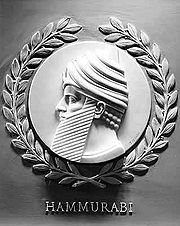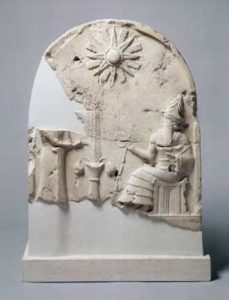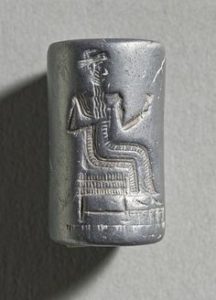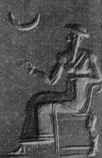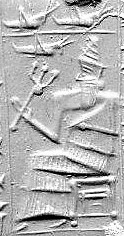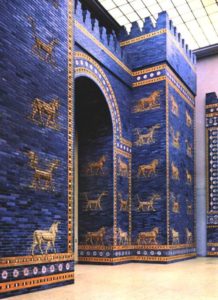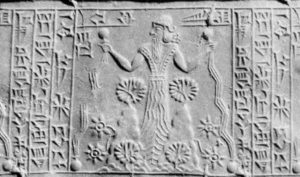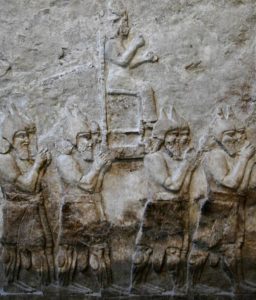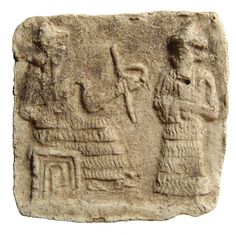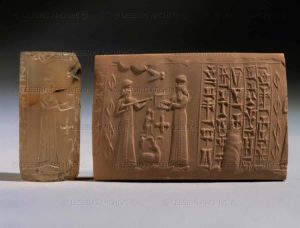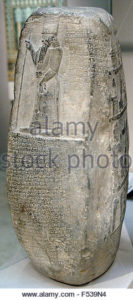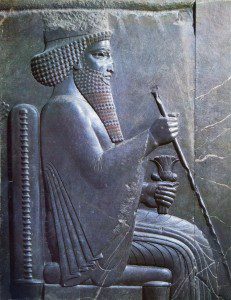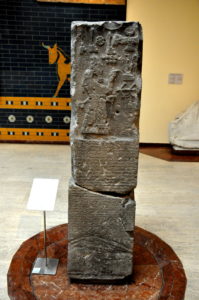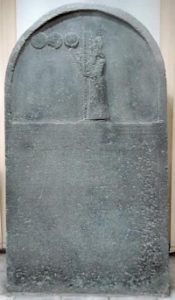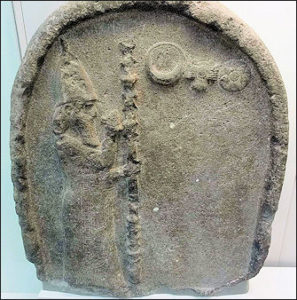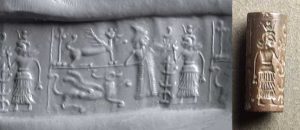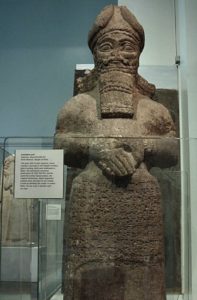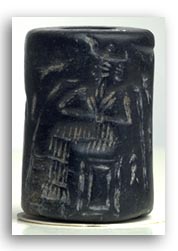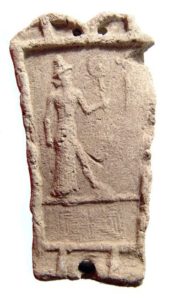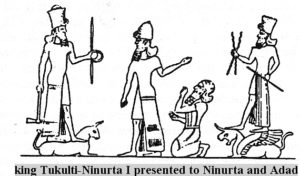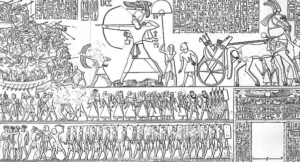http://www.sacred-texts.com/ane/rp/rp201/rp20106.htm
(Texts: All Artifacts, Color Coding, & Writings in Bold Type With Italics Inside Parenthesis, are Added by Editor R. Brown, not the Authors, Translators, or Publishers!)
(gods in blue …mixed-breed demigods in teal…)
Obverse
1. Sumu-abi, the king: 15 years.
2. ’Sumu-la-ilu, the son of the same: 35 years.
3. Zabû, the son of the same: 14 years.
4. Abil-Sin, the son of the same: 18 years.
5. Sin-muballidh, the son of the same: 30 years.
6. Khammu-ragas, 1 the son of the same: 55 years.
7. ’Sam’su-iluna, 2 the son of the same: 35 years.
8. Ebisum, 3 the son of the same: 25 years.
9. Ammi-satana, the son of the same: 25 years.
10. Ammi-sadugga, 4 the son of the same: 21 years.
11. ’Sam’su-satana (?), the son of the same: 31 years.
12. 11 kings of the dynasty of Babylon.
Reverse
1. (The dynasty of) Uru-azagga. 5 Anman the king.
2. Ki-[An] Nigas. 6
3. Damki-ili-su. 7
4. Is-ki-pal. 1
5. Sussi.2
6. Gul-ki-sar.3
7. Kirgal-dara-mas, the son of the same.
8. A-dara-kalama, the son of the same.
9. A-kur-du-ana.5
10. Melam-kurkura. 6
11. Ea-ga(mil?). 7
12. 1[1] kings of the dynasty of Uru-azagga.
Footnotes
13:1 The first five names of the dynasty are Semitic. Khammuragas is Kassite or Kossæan, and is interpreted “of a large family.” Sin-muballidh may have married a foreign wife.
13:2 “The Sun-god (Utu) (is) our god,” another Semitic name.
13:3 “The doer,” also Semitic.
13:4 Kassite, interpreted “the family is established.”
13:5 Uru-azagga is now represented by a part of the mounds of Telloh (the ancient Sirpurla) or its immediate vicinity.
13:6 Nigas was an Elamite word.
13:7 Semitic, signifying “gracious is his god.”
14:1 Perhaps to be read in Semitic Sapin-mat-nukurti, “the sweeper away of the land of the foe.” The name seems to have been a title.
14:2 Perhaps the Semitic sussu, “sixty.”
14:3 In Semitic Muabbid-kissati, “the destroyer of hosts.”
14:4 Apparently, therefore, the son of the preceding king.
14:5 Rendered by the Semitic Abil-Bel-u’sum-same, “the son of Bel (Marduk) (the lord) of the treasury of heaven.”
14:6 “The glory of the world.”
14:7 The last character is partially destroyed. If my restoration is correct, the name would be Semitic and signify “Ea (Enki) has rewarded.”
TRANSLATION OF THE SECOND DYNASTIC TABLET FROM BABYLON
Column I
The first eleven lines are destroyed.
12. 11 kings [of the dynasty of Babylon] for [294 years].
_________
13. Anma[n] for [5]1 (years).
14. Ki-an [Nigas] for 55 (years).
15. Damki-ili[su] for 46 1 (years).
16. Is-ki-[pal] for 15 (years).
17. Sussi, (his) brother, for 27 (years).
18. Gul-ki-[sar] for 55 (years).
19. Kirgal-[dara-mas] for 50 (years).
20. A-dara-[kalama] for 28 (years).
21. A-kur-du-[ana] for 26 (years).
22. Melamma-[kurkura] for 6 (years).
23. Bel-ga[mil?] for 9 (years).
24. For 368 (years) the 11 kings of the dynasty of Uru-azagga.
_________
25. Gandis for 16 (years).
26. Agum-si[pak] his son for 22 (years).
27. Guya-si[pak] for 22 (years). 2
28. Ussi his son for 8 (years).
29. Adu-medas for … (years).
_________
30. Tazzi-gurumas for … (years).
31. [Agum-kak-rimi 1 for … years].
The next line of this column and the first thirteen lines of the next are destroyed.
Column II
14. …… for 22 (years).
15. …… for 26 (years).
16. …… for 17 (years).
17. Kara … 2 for 2 (years).
18. Gis-amme … ti for 6 (years).
19. Saga-sal[tiyas] for 13 (years).
20. Kasbat his son for 8 (years).
2r. Bel-nadin-sumi for 1 year (and) 6 months.
22. Kara-Urus 3 for 1 year (and) 6 months.
23. Rimmon-nadin-suma for 6 (years).
24. Rimmon-suma-natsir for 30 (years).
25. Meli-Sipak 4 for 15 (years).
26. Merodach-abla-iddin (Merodach-baladan) his son for 13 (years).
27. Zamama-nadin-sumi 5 for 1 (year).
28. Bel-suma … 6 for 3 (years).
29. For 576 (years) 9 months the 36 kings [of the dynasty of the Kassites]. 7
_________
30. Merodach- … for 17 (years).
31. ……… for 6 (years).
The next line of this column and the first four of the next are destroyed.
Column III
5. …… for 22 (years).
6. Merodach-nadin- … 1 for 1 year and 6 months.
7. Merodach-kul[lat] … 2 for 13 (years).
8. Nebo-nadin- … for 9 (years).
9. For 72 (years and) 6 months the 22 kings of the dynasty of Isin.
_________
10. Simmas-si[pak] for 18 (years).
11. Bel-mukin-[ziri] for 5 months.
12. Kassû-nadin-akhi for 3 (years).
13. For 21 (years and) 5 months the three kings of the dynasty of the land of the Sea.
_________
14. E-ulbar-sakin-sumi for 17 (years).
15. Uras-kudurri-[utsur] for 3 (years).
16. Silanim (?)-Sugamu[na] for 3 months.
17. For 20 (years and) 3 months the 3 kings of the dynasty of Bit-[Bazi].
_________
18. an … [an Elamite] for 6 (years).
19. …… for 13 (years).
20. …… for 6 months (and) 12 (days).
The next twelve lines of the column and the first line of the fourth column are destroyed.
Column IV
2. Nebo-suma-yukin [the son of Dakuri] for … (years).
3. Nabu-[natsir] 1 for [14] (years).
4. Nebo-nadin-ziri 2 his son for 2 (years).
5. Nebo-suma-yukin his son for 1 month and 12 days.
6. The 31 [kings? 3 of the dynasty of Babylon.
_________
7. Yukin-zira of the dynasty of Sasî 4 for 3 (years).
8. Pulu 5 for 2 (years).
9. Ululâ 6 of the dynasty of Tinu for 5 (years).
10. Merodach-abla-iddina (Merodach-baladan) of the dynasty of the country of the Sea for 12 (years).
11. Sargon for 5 (years).
12. Sin-akhe-erba (Sennacherib) of the dynasty of Khabi the greater for 2 (years).
13. Merodach-zakir-sumi the son of Arad-… for 1 month.
14. Merodach-abla-iddina a soldier of Khabi 7 for 6 months.
15. Bel-ebus of the dynasty of Babylon for 3 (years).
16. Assur-nadin-sumi of the dynasty of Khabi the greater for 6 (years).
17. Nergal-zusezib for 1 (year).
18. Musezib-Merodach of the dynasty of Babylon for 4 (years).
19. Sin-akhe-erba (Sennacherib) for 8 (years).
20. Assur-akhe-iddina (Esarhaddon) for [12 years].
21. Samas-suma-yukin (Saosdukhinos) for [20 years].
22. Kandal-[anu] (Khineladanos) for [22 years].
The rest of the tablet is destroyed.
Footnotes
15:1 Mr. Pinches’ copy gives 36 years.
15:2 Is this king merely a duplicate of his predecessor, the different spelling of the name having caused the annalist to divide one king into two?
16:1 Supplied from an inscription of the king himself, who styles himself the son of Tassi-gurumas, the descendant of Ahi … the son of Agum . and the offspring of the god Suqamuna.
16:2 Identified by Dr. Oppert with Kudur-Bel, who, according to Nabonidos, was the father of Sagasalti-buryas, the latter of whom reigned 800 years before himself (B.C. 1340). But the identification is doubtful, since the names do not agree.
16:3 “The servant of Bel (Marduk)“ (Kudur-Bel) in Kassite.
16:4 “The man of Merodach (Marduk)“ in Kassite.
16:5 Zamama-nadin-sumi was a contemporary of the Assyrian king Assur-dan-an (whose name should probably be read Assur-dan, and be identified with that of Assur-dayan, the great-grandfather of Tiglath-PileserI.)
16:6 Or Bel-nadin- …
16:7 The Kassites were a rude tribe of the Elamite mountains on the northeast side of Babylonia. Nöldeke has shown that they must be identified with the Kossæans ofclassical geography.
17:1 Perhaps Merodach-nadin-akhi, the antagonist of the Assyrian king Tiglath-Pileser I., 418 years before the conquest of Babylon by Sennacherib, and consequently B.C. 1106.
17:2 Perhaps the Merodach-sapik-kullat of the Synchronous Tablet, who was a contemporary of Assur-bil-kala, the son of Tiglath-Pileser I.
17:3 Isin (pa-se) was also called Pate’si (“the city of the high-priest” in Babylonia), according to W.A.I., ii. 53, 13.
17:4 That is, the Persian Gulf. Merodach-baladan is described below as also belonging to the dynasty of the country of the Sea, and his ancestral kingdom was that of the Kaldâ or Chaldees in Bit-yagina among the marshes at the mouth of the Euphrates.
18:1 The Nabonassar of Ptolemy’s Canon, B.C. 747.
18:2 Called Nadinu in the Babylonian Chronicle.
18:3 Possibly we should supply “years” instead of “kings.”
18:4 The annals of Tiglath-Pileser III show that we should read Sapi or Sape. Yukinzira is the Khinziros of Ptolemy’s Canon.
18:5 Pulu is the Pul of the Old Testament, the Pôros of Ptolemy’s Canon. His name is replaced by that of Tiglath-Pileser in the Babylonian Chronicle, and the two years of his reign correspond with the two years during which Tiglath-Pileser reigned over Babylonia.
18:6 The Shalmaneser of the Babylonian Chronicle and the Assyrian monuments, the Ilulaios of Ptolemy’s Canon.
18:7 Does this imply that he was a different person from the famous Merodach-baladan, the contemporary of Sargon and Hezekiah?
TRANSLATION OF THE THIRD DYNASTIC TABLET
Obv.—COLUMN I
Only the ends of two lines in the middle have been preserved.
… 600 (years) he reigned.
[The kings] … (were) in all.
Obv.—COLUMN II
… ili ……
(an) Illadu 1 the son of the same for … (years).
Mul-men-nunna …
Abil (?)-Kis the son of …
Obv.—COLUMN III
Is entirely lost. It contained about seventy lines.
Rev.—COLUMN IV
[The dynasty] of Babylon, [11 kings for 294 years].
’Sumu-[abi for 15 years].
Zabû [for 14 years.]
Abil-Sin [for 18 years].
Sin-[muballidh for 30 years].
The next six lines are destroyed.
The 1[1 kings of the dynasty of Uru-azagga].
For 3[68 years].
_________
An[man] …
Ki[-An-nigas] …
The rest of the column is destroyed.
Rev.—COLUMN V
The marshmen (?) of the country of the sea (were) in all:
_________
The leader of the marshmen (?) of the land of the sea
(was) Siminas-sipak the son of Erba-Sin;
whose reign was prosperous: his god brought him aid;
for 17 years he reigned.
In the palace of Sargon (his corpse) was burned.
Ea-mukin-zira established himself as king,
the son of Kha’smar; 1 for 3 months he reigned.
In the vestments of Bit-Kha’smar he was burned.
Kassû-nadin-akhi the son of Sappâ 2 reigned for 6 years.
[He was burned] in the palace.
The 3 kings of the dynasty of the country of the Sea reigned for 23 years.
_________
[E]-ulbar-sakin-sumi the son of Bazi reigned for 15 years:
in the palace of Kar-Merodach [he was burned].
[Uras]-kudurri-utsur the son of Bazi reigned for 2 years.
[Silanim]-Suqamuna the son of Bazi reigned for 3 months:
in the palace of Lu … Sa [he was burned].
_________
[The 3] kings of the dynasty of the house of Bazi reigned for 20 years (and) 3 months.
…… a descendant of the race of Elam reigned for 6 years.
In the palace of Sargon he was burned.
_________
[One king] of the dynasty of Elam reigned for 6 years.
The rest of the tablet is lost.
Footnotes
20:1 This was the Semitic reading; the Accadian seems to have been Pallil.
21:1 May also be read Kutmar. The word meant “a hawk” in the Kassite language.
21:2 “The Sappite.”
TRANSLATION OF THE BABYLONIAN CHRONICLE
Obv.—COLUMN I
1. [In the 3d year of Nabonassar] king of Babylon
2. [Tiglath-pileser] in Assyria sat on the throne.
3. In the same year [Tiglath-pileser] descended into the country of Accad, and
4. the cities of Rabbiku and Khamranu he spoiled,
5. and the gods of the city of Sapazza he carried away.
_________
6. In the time of Nabu-natsir (Nabonassar) the town of Borsippa (Nabu’s city)
7. was separated from Babylon. The battle which Nabonassar
8. fought against Borsippa is not described. 1
_________
9. In the 5th year of Nabu-natsir Umma(n)-nigas
10. in Elam sat upon the throne.
_________
11. In (his) 14th year Nabu-natsir fell ill and died 2 in his palace.
12. For 14 years Nabu-natsir reigned over Babylon.
13. Nadinu 3 his son sat upon the throne in Babylon.
_________
14. In the second year Nadinu was slain in an insurrection.
15. For two years Nadinu reigned over Babylon.
16. Suma-yukin 4 the governor, the leader of the insurrection, sat upon the throne.
17. For 2 months and … days Suma-yukin reigned over Babylon.
18. Yukin-zira … seized upon the throne.
_________
19. In the 3d year of Yukin-zira Tiglath-pileser,
20. when he had descended into the country of Accad,
21. destroyed Bit-Amukanu and captured Yukin-zira.
22. For 3 years Yukin-zira reigned over Babylon.
23. Tiglath-pileser sat upon the throne in Babylon.
_________
24. In (his) 2d year Tiglath-pileser died in the month Tebet. 1
25. For [22] years Tiglath-pileser the sovereignty over Accad
26. and Assyria had exercised. For two years he reigned in Accad.
27. On the 25th day of the month Tebet Sulman-asarid (Shalmaneser) in Assyria
28. sat upon the throne. He destroyed the city of Sabarahin. 2
_________
29. In (his) 5th year Sulman-asarid died in the month Tebet.
30. For 5 years Sulman-asarid reigned over the countries of Accad and Assyria.
31. On the 12th day of the month Tebet Sargon sat upon the throne in Assyria.
32. In the month Nisan Merodach-baladan sat upon the throne in Babylon.
_________
33. In the 2d year of Merodach-baladan Umma(n)-nigas king of Elam
34. in the province of Dur-ili fought a battle against Sargon king of Assyria, and
35. caused a revolt from Assyria: he overthrew them 1 utterly.
36. Merodach-baladan and his army, which to the assistance
37. of the king of Elam had gone, did not obtain a battle: he arrived too late. 2
_________
38. In the 5th year of Merodach-baladan Umma(n)-nigas king of Elam died.
39. [For 3 years] Umma(n)-nigas reigned over Elam.
40. [Sutruk 3-nankhun]du the son of his sister sat on the throne in Elam.
41. …… up to the 10th year
The remaining lines of the column are destroyed.
COLUMN II
1. In the … the year …
2. A battle …
3. For 12 years [Merodach-baladan reigned over Babylon]. 4
4. Sargon [sat upon. the throne in Babylon].4
The next fourteen lines are destroyed.
19. The Babylonians he did not oppress (?) 5 …
20. he (Sennacherib) was angry also with Merodach-baladan, and [took him prisoner];
2 I. he devastated his country, and …
22. the cities of Larak and Sarraba[nu 6 he destroyed].
23. After his capture (Sennacherib) placed Bel-ibni upon the throne in Babylon.
_________
24. In the first year of Bel-ibni Sennacherib.
25. destroyed the cities of Khirimma and Khararatum.
_________
26. In the 3d year of Bel-ibni Sennacherib into the country of Accad
27. descended, and devastated the country of Accad.
28. Bel-ibni and his officers he transported into Assyria.
29. For 3 years Bel-ibni reigned over Babylon.
30. Sennacherib his son, Assur-nadin-suma
31. placed upon the throne in Babylon.
_________
32. In the first year of Assur-nadin-suma Sutruk-[nan]khundu 1 king of Elam
33. was seized by his brother Khallusu who closed the gate before him. 2
34. For 18 years Sutruk-[nan]khundu had reigned over Elam.
35. His brother Khallusu sat upon the throne in Elam.
_________
36. In the 6th year of Assur-nadin-suma Sennacherib
37. descended into the country of Elam, and the cities of Nagitum, Khilmi,
38. Pellatum and Khupapanu he destroyed.
39. He carried away their spoil. Afterwards Khallusu the king of Elam
40. marched into the country of Accad and entered Sippara on the march (?).
41. He killed some people (but) the Sun-god did not issue forth from the temple of E-Babara.
42. He captured Assur-nadin-suma and he was carried to Elam.
43. For 6 years Assur-nadin-suma reigned over Babylon.
44. The king of Elam placed Nergal-yusezib in Babylon
45. on the throne. He caused [a revolt] from Assyria.
_________
46. In the 1st year of Nergal-yusezib, on the 16th day of the month Tammuz, 1
47. Nergal-yusezib captured Nipur 2 and occupied its neighborhood (?).
48. On the first day of the month Tammuz the soldiers of Assyria had entered Uruk. 3
COLUMN III
1. They spoiled the gods belonging to Uruk as well as its inhabitants.
2. Nergal-yusezib fled after the Elamites, and the gods belonging to Uruk
3. as well as its inhabitants (the Assyrians) carried away. On the 7th day of the month Tisri 4 in the province of Nipur
4. he fought a battle against the soldiers of Assyria and was taken prisoner in the conflict, and
5. he was carried to Assyria. For 1 year and 6 months Nergal-yusezib
6. reigned over Babylon. On the 26th day of the [month Tisri?]
7. against Khallusu king of Elam his people revolted, [the gate before] him
8. they closed. They slew him. For 6 years Khallusu reigned over Elam.
9. Kudur in Elam sat upon the throne. Afterwards Sennacherib
10. descended into Elam and from the country of Rasi as far as
11. Bit-Burna 5 he devastated.
12. Musezib-Merodach sat upon the throne in Babylon.
13. In the first year of Musezib-Merodach on the 17th day of the month Ab 1
14. Kudur king of Elam was seized in an insurrection and killed. For 10 months
15. Kudur had reigned over Elam. Menanu in Elam
16. sat upon the throne. I do not know the year 2 when the soldiers of Elam and Accad
17. he collected together and in the city of Khalule a battle against Assyria
18. he fought, and caused a revolt from Assyria. 3
19. In the 4th year of Musezib-Merodach on the 15th day of Nisan 4
20. Menanu king of Elam was paralysed, 5 and
21. his mouth was seized and he was deprived of speech.
22. On the first day of the month Kisleu 6 the city [of Babylon] was taken, Musezib-Merodach
23. was taken and led away to Assyria.
24. For 4 years Musezib-Merodach reigned over Babylon.
25. On the 7th day of the month Adar 7 Menanu king of Elam died.
26. For 4 years Menanu reigned over Elam.
27. Khumma-khaldasu 8 in Elam sat upon the throne.
_________
28. In the eighth year of the king there was … in Babylon. On the 3d day of the month Tammuz
29. the gods belonging to Erech went down from the city Of Eridu 9 to Erech.
30. On the 3d day of the month Tisri Khumma-khaldasu the king of Elam by the Fire-god
31. was stricken and perished through the power (?) of the god. For 8 years Khumma-khaldasu
32. reigned over Elam.
33. Khumma-khaldasu the second in the country of Elam sat upon the throne.
34. On the 10th day of the month Tebet, 1 Sennacherib king of Assyria
35. by his own son 2 was murdered in an insurrection. For [24] years Sennacherib
36. reigned over Assyria. From the 20th day of the month Tebet until
37. the 2d day of the month Adar is described as a period of insurrection in Assyria.
38. On the 8th day of the month Sivan 3 Assur-akhi-iddina (Esar-haddon) his son sat on the throne in Assyria.
_________
39. In the first year of Esar-haddon, Zira-kina-esir 4 of the sea coast, 5
40. when he had laid fetters on the city of Erech (Uruk), the city. of [Erech?]
41. destroyed in sight of the officers of Assyria and [fled] to the country of Elam.
42. In Elam the king of Elam took him and [slew him] with the sword.
43. In a month I do not know the officer called Gu-enna was … in the city of Nipur.
_________
44. In the month Elul, 6 the god Gu’si 7 and the gods [of the city of …]
45. proceeded to Dur-ili; [the gods of ……]
46. proceeded to Dur-Sargon ……
47. In the month Adar the heads of ……
_________
48. In the second year the major-domo ……
The next two lines are destroyed.
Rev.—COLUMN IV
1. …… akhe-sullim the Gu-enna.
2… [the Gimir]ri 1 marched against Assyria and in Assyria were slain.
3… the city of Sidon was taken; its spoil was carried away.
4. The major-domo mustered a gathering in Accad.
_________
5. In the 5th year on the 2d day of the month Tisri the Assyrian soldiers Bazza 2
6. occupied. In the month Tisri the head of the king of the country of Sidon
7. was cut off, and brought to Assyria. In the month Adar the head of the king
8. of the countries of Gundu and ’Si’sû 3 was cut off and brought to Assyria.
_________
9. In the 6th year the king of Elam entered Sippara. He offered sacrifices. The Sun-god (Utu / Shamash) 4 from
10. the temple of E-Babara did not issue forth. The Assyrians marched into Egypt. Ethiopia was troubled. 5
11. Khumma-khaldasu the king of Elam without being sick died in his palace.
12. For 5 years Khumma-khaldasu reigned over Elam.
13. Urtagu his brother sat upon the throne in Elam.
14. In a month I do not know Nadin-Suma the Gu-enna
15. and Kudur the son of Dakuri went to Assyria.
_________
16. In the 7th year on the 5th day of the month Adar the soldiers of Assyria marched into Egypt.
17. In the month Adar Istar of the city of Accad and the gods of the city of Accad
18. had departed from the country of Elam and on the 10th day of the month Adar entered the city of Accad.
_________
19. In the 8th year of Esar-haddon in the month Tebet on a day of which the date has been lost 1
20. the country of the Rurizâ was occupied; its spoil was carried away.
21. In the month Kisleu its spoil was brought into the city of Ur.
22. On the 5th day of the month Adar the wife of the king died.
_________
23. In the tenth year in the month Nisan the soldiers of Assyria marched into Egypt. 2
24. On the 3d day of the month Tammuz and also on the 16th and 18th days
25. three times the Egyptians were defeated with heavy loss. 3
26. On the 22d day Memphis, 4 the royal city, was captured.
27. Its king fled; his son descended into the country of [Ethiopia].
28. Its spoil was carried away; [its] men were [enslaved]; its goods were ……
_________
29. In the 11th year the king [remained] in Assyria; his officers ……
_________
30. In the 12th year the king of Assyria ……
31. On the march he fell ill, and died on the 10th day of the month Marchesvan. 1
32. For 12 years Esar-haddon reigned over Assyria.
33. Saul-suma-yukina in Babylon, Assur-bani-pal in Assyria, his two sons, sat on the throne.
_________
34. In the accession year of Saul-suma-yukina in the month Iyyar, 2
35. Bel (Marduk) and the gods of Accad from the city of Assur
36. had gone forth and on the 11th day of the month Iyyar had entered into Babylon.
37. In that year [against] the city of Kirbitum 3 [there was war]; its king is conquered.
38. On the 10th day of the month Tebet Bel-edir-nisi (?) in Babylon is seized and put to death.
_________
39. The first part (of the chronicle) has been written like its original and has been made public.
40. The tablet of Ana-Bel-kan the son of Libludhu
41. the son of Nis-Sin, by the hand of Ea-iddin the son of
42. Ana-Bel-kan the son of Libludhu of Babylon,
43. the 5th day of the month … the 22d year of Darius king of Babylon,
44. the king of the world.”
Footnotes
22:1 That is, in the history from which the writer extracted his chronicles.
22:2 Literally “fate” (overtook him).
22:3 The Nebo-nadin-ziri (“Nebo has given a seed”) of the Dynastic Tablet; Nadios in Ptolemy’s Canon.
22:4 Called Nebo-suma-yukin in the Dynastic Tablet.
23:1 December.
23:2 Not to be confounded with ’Samerina or Samaria. M. Halévy may be right in identifying it with the city of Sibraim mentioned in Ezek. xlvii. 16 as lying between Damascus and Hamath.
24:1 That is, the Assyrians. The Annals of Sargon, on the other hand, claim the victory for Assyria, though Babylonia was left in the hands of Merodach-baladan.
24:2 Literally, “he undertook it too late” (ana arki itsbat-’sa).
24:3 The Elamite Sutruk was identified by the Assyrians with their goddess Istar (Inanna).
24:4 So restored by Winckler.
24:5 Ikhmi’s.
24:6 See W.A.I., ii. 69, No. 5, 13. Larak was the Larankha of Berossos, which the Greek writer seems to have confounded with Surippak near Sippara.
25:1 Written Is-tar-khu-un-du. The Susian inscriptions of the king himself write the name Su-ut-ru-uk-[an]-Nakh-khu-un-te.
25:2 That is, imprisoned him.
26:1 June.
26:2 Now Niffer.
26:3 Now Warka, the Erech of Gen. x. 10.
26:4 September.
26:5 Bit-Burna (-ki) is called Bit Buna (-ki) in the annals of Sennacherib.
27:1 July.
27:2 The chronicler’s sources here failed him, but Winckler has pointed out that the battle of Khalule must have taken place in either B.C. 691 or 690.
27:3 The annals of Sennacherib claim a complete victory for the Assyrians.
27:4 March.
27:5 Literally, “Tetanus constricted him” (misidtuv imisid, cf. W.A.I., ii. 27. 47, 48).
27:6 November.
27:7 February.
27:8 Called Umman-aldas in the Assyrian inscriptions.
27:9 Eridu was on the coast of the Persian Gulf.
28:1 December.
28:2 It will be noticed that the chronicler speaks of only one son, whereas two are named in the Old Testament.
28:3 May.
28:4 Called by Esar-haddon Nebo-zira-kina-esir (“Nebo (Nabu) has directed the established seed”), the son of Merodach-baladan.
28:5 That is, of the Persian Gulf.
28:6 August.
28:7 “The god of the favorable mouth,” a local divinity (perhaps belonging to Sippara, W.A.I., v. 3r, 30), and identified with Uras (W.A.I., ii. 57, 54).
29:1 So restored by Winckler. The Gimirrâ are the Gomer of the Old Testament, the Kimmerians of classical writers.
29:2 Apparently the district of Arabia Petræa called Bazu by Esar-haddon, Buz in the Old Testament.
29:3 Probably in Kilikia.
29:4 The Sun-god (Utu) whose temple has been discovered by Mr. Hormuzd Rassam in the mounds of Abu-Habba was the patron-deity of Sipar or Sippara. Besides “Sippara of the Sun-god,” there was a neighbouring city called “Sippara of Anunit (Inanna?).” The two together formed the Scriptural Sepharvaim or “two Sipparas.”
29:5 Melukh imina.
30:1 In the history from which the chronicler derived his account.
30:2 The chronicler notes here that the last character in the line was wanting in his copy.
30:3 Literally, “massacres took place in Egypt.”
30:4 Written Membi.
31:1 October.
31:2 April.
31:3 Apparently the city of Karbat in Northern Egypt, conquered by Assur-bani-pal at the commencement of his reign.
